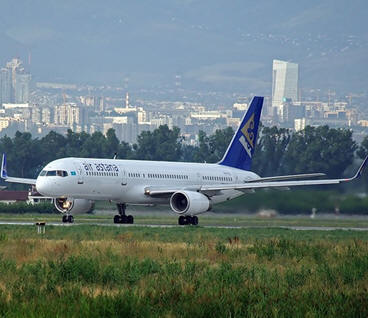|
“Such a commitment to globally recognized standards will
improve safety performance and make a compelling case
for the European Union to review its evaluation of the
region,” said Tyler, referring to the EU list of banned
carriers. Kazakhstan and the Kyrgyz Republic are among
the states whose carriers are banned from flying to
Europe. Air Astana serves Europe, on an exceptional
basis and with restrictions.
Growth in connectivity is in danger of being compromised
by airport infrastructure that is comparatively
expensive and not keeping pace with demand growth. “The
plans for a new terminal at Almaty airport in Kazakhstan
are welcome, but the capacity increase lags the growth
projections. We need to think strategically to ensure
that economic opportunities are not artificially
constrained by lack of infrastructure,” said Tyler. IATA
is partnering with the Kazakhstan Ministry of Transport
and Communications to ensure that airline requirements
are met as it attempts to ensure that 15 of the
country’s 20 airports comply with ICAO requirements by
2020.
At
the same time, IATA is urging the Kazakhstan government
to follow ICAO principles and eliminate differential
ANSP charges between domestic and international
carriers. Moreover, IATA is urging the implementation of
independent economic regulation to safeguard
international principles and standards, ensure
investment in capacity and quality initiatives, and
enforce a transparent consultation process for both
setting charges and deciding on investments. “It is 18%
more expensive to turn around an Airbus A320 in Almaty
than at similarly-sized airports in Europe. And the
differential rises to 43% for a Boeing 767. My concern
grows when you see that costs are increasing, instead of
becoming more competitive,” said Tyler.
ICAO has established principles for airport charges and
development fees, including full and transparent
consultation, cost-benefit analysis, and service-level
agreements. “When followed correctly, these principles
result in a proper balance between paying for facilities
and new infrastructure, and allowing for businesses to
enjoy profitable growth,” said Tyler.
IATA announced the establishment of its first office in
Central Asia and the Caucasus. Attached to the IATA
European regional office in Madrid, an IATA presence has
been established in Astana. The development
of air connectivity has been a key contributor to
Kazakhstan’s phenomenal economic success, and air travel
in Kazakhstan grew by 22% in 2011 (compared to 2010).
“For the landlocked expanse of Central Asia, at the
crossroad of some of the world’s greatest markets, the
potential for aviation to drive economic growth and
development is almost without limit. IATA is committed
to working alongside all stakeholders in Central Asia
and the Caucasus for the safe, efficient and sustainable
development of air transport,” said Tyler.
|



